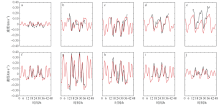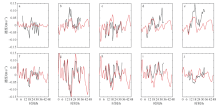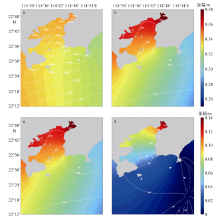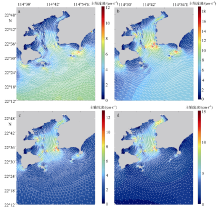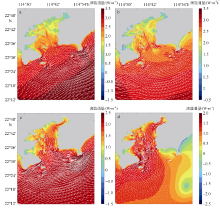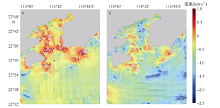Journal of Tropical Oceanography ›› 2017, Vol. 36 ›› Issue (3): 34-45.doi: 10.11978/2016078CSTR: 32234.14.2016078
• Orginal Article • Previous Articles Next Articles
Study on the tidal dynamics in Daya Bay, China — Part I. Observation and numerical simulation of tidal dynamic system
Wen WU1( ), Yuhan YAN1,2, Dehai SONG2
), Yuhan YAN1,2, Dehai SONG2
- 1. College of Oceanic and Atmospheric Sciences, Ocean University of China, Qingdao 266100, China
2. Key Laboratory of Physical Oceanography, Ministry of Education, Ocean University of China, Qingdao 266100, China
-
Received:2016-08-23Revised:2016-09-22Online:2017-05-20Published:2017-06-01 -
Supported by:Major State Basic Research Development Program (2015CB452905);China Postdoctoral Science Foundation (2015T80742)
Cite this article
Wen WU, Yuhan YAN, Dehai SONG. Study on the tidal dynamics in Daya Bay, China — Part I. Observation and numerical simulation of tidal dynamic system[J].Journal of Tropical Oceanography, 2017, 36(3): 34-45.
share this article
Add to citation manager EndNote|Reference Manager|ProCite|BibTeX|RefWorks

Fig. 2
Observed and simulated water levels and tidal-current velocity. (a) Time series of observed and simulated water level at Station T1, and (b) at Station T2. (c) Observed and simulated vertically-averaged northward tidal-current velocity at Station C2 of spring tides, and (d) of neap tides, with the measured water level at Station T1 used as reference"

Tab. 1
Harmonic constants for the main tides at stations T1 and T2"
| 分潮 | T1 | T2 | ||
|---|---|---|---|---|
| 振幅 /cm | 迟角/º | 振幅/cm | 迟角/º | |
| O1 | 27.62 | 245.4 | 27.28 | 244.1 |
| K1 | 33.46 | 296.4 | 32.93 | 294.0 |
| M2 | 36.71 | 257.0 | 33.58 | 254.0 |
| S2 | 14.79 | 286.2 | 13.77 | 283.7 |
| M4 | 13.17 | 288.5 | 8.98 | 280.1 |
| MS4 | 10.81 | 341.7 | 7.22 | 333.3 |
| M6 | 10.80 | 107.0 | 3.83 | 89.9 |
| 2MS6 | 10.69 | 175.2 | 3.78 | 159.2 |
Tab. 2
Errors of harmonic constants for the main tides between observation and simulation at stations T1 and T2"
| 分潮 | T1 | T2 | ||||
|---|---|---|---|---|---|---|
| 振幅/cm | 迟角/º | Diff/cm | 振幅/cm | 迟角/º | Diff/cm | |
| O1 | -0.11 | 0.10 | 0.11 | 0.12 | 0.30 | 0.17 |
| K1 | -0.78 | 0.80 | 0.93 | -0.25 | -0.20 | 0.26 |
| M2 | -0.22 | 0.20 | 0.24 | 0.11 | 0.20 | 0.17 |
| S2 | -0.29 | -0.70 | 0.35 | 0.08 | 0.60 | 0.16 |
| M4 | 0.09 | -0.20 | 0.10 | -0.01 | 0.40 | 0.07 |
| MS4 | 0.10 | -0.50 | 0.13 | -0.02 | 0.90 | 0.12 |
| M6 | -0.01 | 0.40 | 0.09 | -0.02 | -0.90 | 0.06 |
| 2MS6 | -0.25 | -0.50 | 0.27 | -0.02 | -0.10 | 0.02 |
| [1] | 王聪, 林军, 陈丕茂, 等, 2008. 大亚湾水交换的数值模拟研究[J]. 南方水产, 4(4): 8-15. |
| WANG CONG, LIN JUN, CHEN PIMAO, et al, 2008. Numerical simulation on water exchange in Daya Bay[J]. South China Fisheries Science, 4(4): 8-15 (in Chinese). | |
| [2] | 王雪辉, 杜飞雁, 邱永松, 等, 2010. 1980—2007年大亚湾鱼类物种多样性、区系特征和数量变化[J]. 应用生态学报, 21(9): 2403-2410. |
| WANG XUEHUI, DU FEIYAN, QIU YONGSONG, et al, 2010. Variations of fish species diversity, faunal assemblage, and abundances in Daya Bay in 1980-2007[J]. Chinese Journal of Applied Ecology, 21(9): 2403-2410 (in Chinese). | |
| [3] | 吴玲玲, 易斌, 林瑞, 等, 2009. 大亚湾生态监控区生态环境问题及管理对策研究[J]. 海洋开发与管理, 26(1): 14-20. |
| [4] | 吴仁豪, 蔡树群, 王盛安, 等, 2007. 大亚湾海域潮流和余流的三维数值模拟[J]. 热带海洋学报, 26(3): 18-23. |
| WU RENHAO, CAI SHUQUN, WANG SHENG’AN, et al, 2007. Three-dimensional numerical simulation of tidal current and residual current at Daya Bay[J]. Journal of Tropical Oceanography, 26(3): 18-23(in Chinese). | |
| [5] | 吴岩, 陶建华, 1998. 大亚湾潮流数学模型的校准及验证[J]. 港工技术, (1): 6-11. |
| WU YAN, TAO JIANHUA, 1998. The calibration and verification of tide current model of Daya Bay[J]. Port Engineering Technology, (1): 6-11(in Chinese). | |
| [6] | 杨国标, 2001. 大亚湾海区潮流运动特征[J]. 人民珠江, (1): 30-32. |
| [7] | BLANTON J O, LIN GUOQING, ELSTON S A, 2002. Tidal current asymmetry in shallow estuaries and tidal creeks[J]. Continental Shelf Research, 22(11/13): 1731-1743. |
| [8] | CHEN CHANGSHENG, LIU HEDONG, BEARDSLEY R C, 2003. An unstructured grid, finite-volume, three-dimensional, primitive equations ocean model: Application to coastal ocean and estuaries[J]. Journal of Atmospheric and Oceanic Technology, 20(1): 159-186. |
| [9] | CHEN CHANGSHENG, BEARDSLEY R C, COWLES G, 2006. An unstructured grid, finite-volume coastal ocean model (FVCOM) system[J]. Oceanography, 19(1): 78-89. |
| [10] | DRONKERS J, 1986. Tidal asymmetry and estuarine morphology[J]. Netherlands Journal of Sea Research, 20(2/3): 117-131. |
| [11] | FOREMAN M G G, HENRY R F, WALTERS R A, et al, 1993. A finite element model for tides and resonance along the north coast of British Columbia[J]. Journal of Geophysical Research, 98(C2): 2509-2531. |
| [12] | GUO WENYUN, SONG DEHAI, WANG XIAOHUA, et al, 2016. Contributions of different tidal interactions to fortnightly variation in tidal duration asymmetry[J]. Journal of Geophysical Research, 121(8): 5980-5994. |
| [13] | LEFFLER K E, JAY D A, 2009. Enhancing tidal harmonic analysis: robust (hybrid L1/L2) solutions[J]. Continental Shelf Research, 29(1): 78-88. |
| [14] | PAWLOWICZ R, BEARDSLEY B, LENTZ S, 2002. Classical tidal harmonic analysis including error estimates in MATLAB using T_TIDE[J]. Computers & Geosciences, 28(8): 929-937. |
| [15] | SONG XINGYU, HUANG LIANGMIN, ZHANG JIANLIN, et al, 2009. Harmful algal blooms (HABs) in Daya Bay, China: an in situ study of primary production and environmental impacts[J]. Marine Pollution Bulletin, 58(9): 1310-1318. |
| [16] | SONG DEHAI, WANG XIAOHUA, ZHU XUEMING, et al, 2013. Modeling studies of the far-field effects of tidal flat reclamation on tidal dynamics in the East China Seas[J]. Estuarine, Coastal and Shelf Science, 133: 147-160. |
| [17] | SONG DEHAI, YAN YUHAN, WU WEN, et al, 2016. Tidal distortion caused by the resonance of sexta-diurnal tides in a micromesotidal embayment[J]. Journal of Geophysical Research, 121(10): 7599-7618. |
| [18] | YU JING, TANG DANLING, WANG SUFEN, et al, 2007. Changes of water temperature and harmful algal bloom in the Daya Bay in the Northern South China Sea[J]. Marine Science Bulletin, 9(2): 25-33. |
| [1] | WANG Xu, QU Ke, WANG Zijun, YANG Yuanping, WANG Chao, ZHANG Liangbin. Numerical simulation study on the effect of wind on the hydrodynamic characteristics of undular tidal bores seawall [J]. Journal of Tropical Oceanography, 2024, 43(5): 116-130. |
| [2] | WU Hongbo, LUO Feng, CHEN Zhipeng, ZHU Fei, ZENG Jingwei, ZHANG Chi, LI Ruijie. A novel pattern for predicting the effects of mangrove ecological reconstruction [J]. Journal of Tropical Oceanography, 2024, 43(4): 86-97. |
| [3] | XI Chen, LIN Zongxuan, SA Rula, DENG Xi, LIU Qiang, NI Liang, LUO Laicai, MA Teng, XIE Zhijie, CHEN Siruo, CHEN Songze. Analysis of water environmental changes and influencing factors in the southwestern waters of the Daya Bay based on continuous monitoring data from dual buoys [J]. Journal of Tropical Oceanography, 2024, 43(4): 153-164. |
| [4] | ZHANG Zheran, HU Junyang, ZHOU Kai, ZHANG Penghui, XING Jiuxing, CHEN Shengli. Storm surge simulations of the coastal area of Shenzhen using different types of typhoon meteorological fields—a case study of Typhoon Mangkhut* [J]. Journal of Tropical Oceanography, 2023, 42(6): 1-14. |
| [5] | SUN Cuici, YUE Weizhong, ZHAO Wenjie, WANG Youshao. Distribution of the microbial Carbohydrate-Active enzymes genes in the surface sediment of the Daya Bay, China [J]. Journal of Tropical Oceanography, 2023, 42(5): 76-91. |
| [6] | SONG Xingyu, LIN Yajun, ZHANG Liangkui, XIANG Chenhui, HUANG Yadong, ZHENG Chuanyang. Distribution characteristics and influencing factors of meso- and micro-zooplankton communities in the offshore waters of the Guangdong-Hong Kong-Macao Greater Bay Area* [J]. Journal of Tropical Oceanography, 2023, 42(3): 136-148. |
| [7] | ZHANG Min, WU Hangxing, LU Yibin, LU Diwen, MI Jie, ZHU Donglin, CHEN Bo. Impact of the coastal reclamations on topography evolution in the Qinzhou Bay, Guangxi [J]. Journal of Tropical Oceanography, 2023, 42(2): 124-131. |
| [8] | JIANG Xun, WU Wen, SONG Dehai. Identification and quantitative analysis of key controlling factors of water quality response to human activities in the Daya Bay, China [J]. Journal of Tropical Oceanography, 2023, 42(1): 182-191. |
| [9] | GU Jinghua, ZHU Jianrong, JIN Zhi. Numerical simulation of oil film drift and diffusion after oil spill accident at the Baosteel wharf in the Changjiang Estuary [J]. Journal of Tropical Oceanography, 2022, 41(6): 159-170. |
| [10] | CHEN Jingfu, ZHONG Yu, WANG Lei, GUO Yupei, QIU Dajun. Noctiluca scintillans effects on eukaryotic plankton community structure using Environmental DNA analysis in Daya Bay* [J]. Journal of Tropical Oceanography, 2022, 41(5): 121-132. |
| [11] | ZHANG Wanru, LIU Qingxia, HUANG Honghui, QIN Xiaoqing, LI Jiajun, CHEN Jianhua. Study on stable isotopes of carbon and nitrogen of main fishery organisms in the southwestern waters of Daya Bay, South China Sea in winter 2020 [J]. Journal of Tropical Oceanography, 2022, 41(3): 147-155. |
| [12] | LI Yao, XIANG Chenhui, JIANG Zhijian, SONG Xingyu. Production and metabolism characteristics of planktonic community and their influencing factors in Daya Bay during summer* [J]. Journal of Tropical Oceanography, 2021, 40(6): 83-92. |
| [13] | WANG Renzheng, SHAN Zhengduo, MENG Siyu, GONG Xiang. Interannual variation of subsurface chlorophyll maximum in the northern South China Sea [J]. Journal of Tropical Oceanography, 2021, 40(6): 63-75. |
| [14] | XIANG Chenhui, LIU Jiaxing, KE Zhixin, ZHOU Linbin, TAN Yehui. Phytoplankton responses to Dan’ao River estuary water enrichment in terms of size structure and community composition* [J]. Journal of Tropical Oceanography, 2021, 40(2): 49-60. |
| [15] | ZHANG Hua, WEN Xixi, PENG Shiqiu. Numerical simulation of barotropic tides in Mozambique Strait and its adjacent coastal area and energy budget analysis* [J]. Journal of Tropical Oceanography, 2021, 40(2): 7-16. |
|
||








